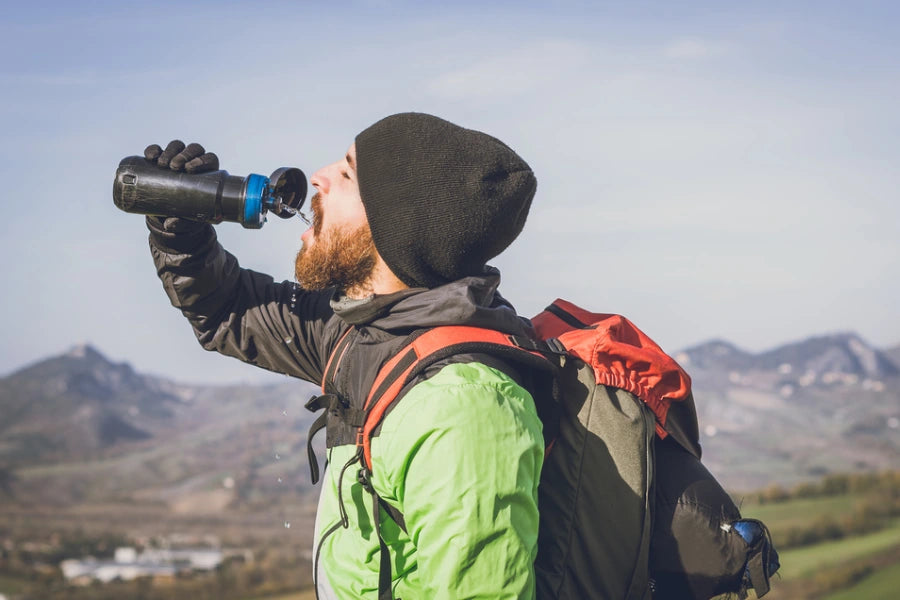How to Stay Hydrated on Your Next Hike

We’re all about making sure your mission goes off without a hitch.
Staying hydrated is crucial for any outdoor activity but is imperative during a hike. Whether tackling a tough mountain hike or marking the boundaries of your hunt camp, your hydration plan and gear like the proper backpack and right size bladder can be the difference between an enjoyable and miserable adventure.
We want you equipped with the best gear and hydration for a successful trek. Let’s figure out how much water for a hike is necessary to carry along and share some top tips for keeping hydrated while hitting the trails.
Understanding Your Hydration Needs
How much water you bring to a hike can vary based on several factors. This includes factors such as the weather, activity level, altitude, and individual hydration requirements. As a general guideline, you should aim for around half a liter or 17 ounces of water per hour during moderate activity in moderate temperatures.
When the heat is on or when you’re tackling a challenging hike, increasing your water intake is crucial to keeping dehydration at bay. Aim for around one liter or 34 ounces per hour to stay adequately hydrated during your trek.
Creating a Hydration Plan
Consider where you are going when determining how much water to bring on a hike. If this is a new route for you, do some research to see how challenging the hike may be. Even seasoned hikers should calculate how much water to carry, even on familiar trails.
Short Hikes
Keeping hydrated for short hikes under two hours is key to an enjoyable and safe trek. Packing a water bottle or a hydration bladder with 1-2 liters of water should be sufficient to keep you refreshed along the way. Remember to hydrate well before hitting the trail to kickstart your adventure on the right note.
Long or Rigorous Hikes
Longer hikes demand endurance and higher physical exertion, so you must take a strategic approach to determine how much water a hike requires. Proper planning, adequate gear, nutrition, and hydration are essential for a successful and enjoyable trek.
You should consider:
- Any water sources on your trail: Research your route ahead of time to identify potential water sources along the way. By knowing where you can refill your water supply, you can carry less weight in your pack and stay hydrated throughout your journey.
- Keeping a method of purification with you: When refilling from natural water sources, having a reliable water purification method will ensure your safety. Options like filters, purification tablets, or UV purifiers can help remove harmful contaminants and pathogens, keeping you healthy and hydrated during your outdoor adventures.
- Maintain a backup water supply: It’s always wise to be prepared for water supply. If you’re unsure how much water to bring for a hike, carry as much as possible. Carrying extra water ensures you’re ready for any unforeseen circumstances like emergencies, delays, or if you take a wrong turn. Large bags like our Elite Duffel bag have a water bottle pocket and ample room for more bottles.

Signs of Dehydration
Knowing how much water to bring on your hike is important to your health and wellbeing.
Stay vigilant about your hydration status. Dehydration can sneak up on you unexpectedly. It’s essential to listen to your body and watch out for signs like:
- dizziness
- dry mouth
- fatigue
- confusion
- lack of energy
- cramps
When your body signals that it needs a break, you should listen. Ignoring symptoms can do more harm than good. Hydrate, take a breather, and assess whether it’s wise to keep going. Your wellbeing and enjoyment are worth prioritizing.
Tips for Staying Hydrated on a Hike
Every hiker’s body is different, and it’s important to listen to your body and adjust your hydration needs based on your personal experience, fitness level, and the specifics of the hike.
Your body knows best what it needs, so pay attention to its signals while on the trails.
Factors like your fitness level and the hike’s intensity can all impact how much water a hike requires. You should follow these tips to stay hydrated:
- Drink regularly during your hike, even at cooler temperatures. You shouldn’t wait until you’re thirsty to drink. Remember, thirst is a sign that you’re becoming dehydrated. Using a hydration bladder with our Crusher backpack or Backlash backpack makes it more accessible.
- Set up regular drinking reminders throughout your hike if necessary.
- Replenish lost electrolytes. Carry electrolyte tablets or powders to help restore minerals lost through sweat.
- Avoid diuretics like coffee and alcohol.
- Use hydrating foods in your snacks and meals.
Get Tactical with Your Hikes
When you’re out on a hike, you should stay prepared for everything. You should know how much water hiking requires, bring enough food, and carry essential gear like a GPS and medical kit. Of course, you need the right bag and accessories by your side.

